Artopia: October 2005 Archives
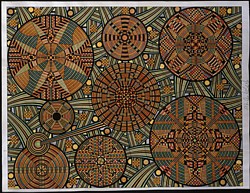

Eugene Andolsek, Untitled.
When Outsiders Come Inside
If work by the five artists presented in "Obsessive Drawing" (American Folk Art Museum, 45 W. 53rd St., to March 19) were displayed in a Chelsea Gallery sans Outsider i.d., would we know the artists were self-taught?
For argument's sake -- and since, alas, there is no catalog -- let's at first limit ourselves to the biographical information in the handout. Chris Hipkiss was born in France in 1964, but now lives in Great Britain; Hioyuki Doi, born in Japan in 1946, is a trained chef and cooking teacher. Martin Thompson: born 1956 in New Zealand; Charles Benefiel, born 1967, Santa Monica; and Eugene Andolesek, born 1921, now lives in a home for senior citizens. In terms of the latter, surely you know that even some trained artists might end up in a senior home in spite of their MFA certifications. As for Hioyuki Doi, it is not unheard of that trained artists have day jobs; his just happens to involve food.
Fortunately, the wall texts provide more information and interpretation, and if for some reason you didn't know where you were, reading would clue you in. Although the artists are tagged as emerging (an art-world term), you'd understand that this was not art-school art.
We learn that "like the other artists in this exhibition, Thompson works on his drawings as part of a self-development system for survival. It helps him negotiate the world, which he calls 'a mindless distraction.' "
The world is indeed a mindless distraction.
Further: "Like Charles Benefiel, Thompson also recites a mathematical equation while making his marks."
I am a student of wall texts. Curator Brooke Davis Anderson's texts (which he either wrote or certainly approved) are masterful compared to: "The rolling locks of Saint Luke's beard flow like smoky puffs, defining spatial volume yet lending an otherworldly quality to the massive form." This choice bit of poppycock can be found in on the walls of the Metropolitan Museum of Art as part of "Prague: The Crown of Bohemia" (to January 3), an exhibition more about gold than anything else: Jan Hus the iconoclastic "heretic" is mentioned in passing, and the Jews of Prague are represented by a photo of the Old New Cemetery. Hus, after all, was against idolatry. And the Jews, it would appear, did nothing except die.
The truly crowd-pleasing, but ultimately boring, "Vincent Van Gogh: The Drawings" at the same institution has an introductory wall text that calls him a self-taught artist. Well, technically, I suppose so. Although it seems hard to imagine he learned nothing about art from Theo, his mainstay and art dealer brother. I should know.
Not only is Vincent my art world great uncle, I played him on Dutch television in artist Les Levine's 1980 Analyze Lovers: The Story of Vincent. Levine was miffed that the reporters at the press conference were more interested in the wonderful new actor playing van Gogh than the layering of multiple interviews on the tape. And although Levine credits himself as script-writer, I made up my own lines and, more importantly, knew enough to hold back true expressiveness until I was asked to talk about cutting off my ear. Levine was a good sport. He brought back a T-shirt with a picture of me as Vincent on it and the words: "I found him an art critic and I made him a star."
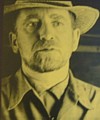
Les Levine: Analyse Lovers (John Perreault as Vincent), 1990
And the Winner Is...
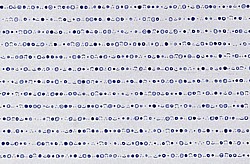
Charles Benefiel: Random Numeric Repeater #9 (detail)
Since it falls to me to make the cut (as I did recently when it comes to the appropriation artists), I will conclude that in terms of the art in "Obsessive Drawing" at the Folk Art Museum or more correctly the Museum of Self-Taught Artists Excluding Van Gogh, Hipkiss' huge narrative scroll moves me not nearly as much as violent, pedophilic, apocalyptic Henry Darger, well-represented in the this museum with his novelistic mayhem. Hiroyuki Doi's wispy drawings, using thousands of tiny circles, cannot match the now-classic dots of Kusama, who, by the way, is an art-world artist who has assigned herself to live in a sanitarium. Andolsek has the black outlines that I associate with Cply, and Thompson's graph-paper exercises work only where his scalpel-hewn corrections interfere with the flatness of the grid.
This leaves Benefiel, whose code drawing stretches out line after line, not like some kooky Agnes Martin, but a text to be spoken aloud or sung. I was so enamored of this nonvisual act of drawing that I copied the code in my notebook: one dot is BA, two is MA, three in a triangle formation is TE; a circle is DA; a half a circle facing up like a smile with a dot is LE; a filled-in circle with a white dot at the center is KA; an upside down half circle with two eye-like dots is PE; a small black circle is FA. A circle with a black dot at its center is ME; a bigger black dot, all filled in is NA.
Without the Folk Art Museum context and without the wall texts, I don't think we could distinguish any of this work from the postgraduate art we see in Chelsea and Williamsburg. With the exception of Benefiel.

Martin Thompson, Untitled.
Another Theoretical Transplant
Could we do the reverse? Choose "obsessive" work by postgraduate artists and, placing it in the Folk Art Museum, have that art taken as Outsider, Visionary, Self-Taught? You bet.
Could it be that going to art school makes no difference? Or -- and here is a more complicated thought - that art schools (and I include college and university art departments) now teach perfectly respectable, middle-class artist wannabes to imitate the personal, anguished, obsessive, visionary art of the untrained, inadequately socialized, demented or inspired Outsider Artist?
We have been Dubuffeted. Jean Dubuffet was a wine merchant and collector of what he called Art Brut (i.e., art of the institutionalized). Influenced by his surrealist wine customers -- who, like Max Ernst, had made careers of imitating the insane - he himself suddenly started making pseudo-Art Brut. Every high school student with artistic sensibilities is infected with tales of van Gogh and Gauguin: the first shot himself and the second, his equally deranged friend, ran away to Tahiti. The first sentence of the wall-text intro to the Met's blockbuster "Drawings of Van Gogh" (through Dec. 31) deems him a self-taught artist! What an odd thing to emphasize. When academically institutionalized, some young artists now get infected by tales of Ernst and Dubuffet. You don't have to be insane, you can imitate the insane. I suppose this is progress.
Or is it that "trained" artists can also be demented, visionary outsiders and may have ended up in art schools because there's no other place for them?
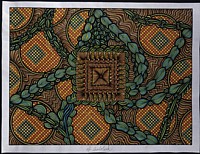
EugeneAndolsek, Untitled
The Name Game
Can we tell the difference between the work in "Obsessive Drawing" and the folk art on the other floors of the Folk Art Museum? Certainly, the work in this concise and thoughtful exhibition looks more like contemporary art than most of what previously we have known as folk art. Will anyone be confused? Probably not, until the question of what these drawings are doing in a museum once devoted to folk art.
Usually I am for the breaking and blurring of categories, but here I have some doubts. The self-taught common denominator appears to be a ruse to lure both funding and audience. Outsider Art, given the success of the annual N.Y. Outsider Art Fair, is wildly popular. Since there is little left to collect, Folk Art has had its day. However, folk artists are not self-taught; they are academically untrained, but they are usually taught as apprentices.
Across the street at the Museum of Arts and Design (M.A.D., indeed) we have an even worse problem, since this new name of the American Craft Museum - where I am obligated to disclose I once worked - does not mean anything at all. Talk about a loss of identity! Hey, craft by any other name is still craft. It can indeed be art, but it is never design per se. Design is something you usually do before you make something, or, more particularly, it is both the planning and the result of industrial production. Design is not handmade by the artist himself or herself.
Language!
And if the former American Craft Museum, in a total betrayal of the American Craft Movement, is now going to be a design museum, there's some pretty tough competition already in place, in the form of MoMA and the Cooper-Hewitt, to name but two already up-and-running gift-shop platforms.
Isn't there some law against false advertising? Or can we call any holding of objects anything: as long as the name satisfies some funder, is a response to focus groups, or seeks some imaginary, magical, money-bearing public? If so, based on various fantasy demographics and purposes I propose:
The Museum of NOT-Craft
The Museum of Insider Art, Postal Service, and Postgraduate Installations
The Museum of Nudes and Clothing
The Museum of Dead Grandmothers
The Museum of Dead Boards of Directors
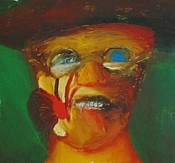
Sir Sydney Nolan, Ern Malley (detail)
The Sound Track Like a Trail of Saliva
Are there fake Outsider artists? Of course. An informant has it that a college-professor artist he knows shows every year at the Outsider Art Fair and is now making enough money to retire...so he can pursue his "real" art?
How can you tell the difference between Outsider Art and Art School Art? You can't really, except by intuition and additional information.
And does it matter? Sincerity cannot be seen or measured.
When I was barely out of high school, I was able to visit the studio of my first "real" artist. He made his living by producing "Madonna and Child" paintings for the Washington Square Outdoor Art Show. But when with great fanfare he showed us his "real" art, abstract paintings of no interest, it was clear that the only real art he was producing was his "Madonna and Child" paintings.
I am also reminded of Ern Malley, my favorite Australian modernist poet. He was invented one afternoon in 1943 by two antimodernist wags by the name of James McAuley and Harold Stewart. But here's the rub: the fake poems (rather like a combination of T. S. Eliot and Edward Lear), are actually more interesting than any serious poems produced by these naughty hoaxers. The Ern Malley Affair by Michael Heyward, University of Queensland Press, includes all 16 Malley poems. And a lot more.
So which do you prefer?
How often have I sat at evening
Under the painted alcove of the sun
The secretary of its facile flame!
-- James McAuley
Or:
Innumerable images
The register of birth and dying
Under the carved rococo porch
The Tigris - Venice - Melbourne - the Che'en Plain -
And the sound track like a trail of saliva.
-- Ern Malley
* * *
If art can save you from madness, can it also cause madness? Or is it the art world that does this?
For more on Outsider Art (Judith Scott's wrapped sculptures) go to johnperreault.com.
Note: Next week Artopia goes on vacation.
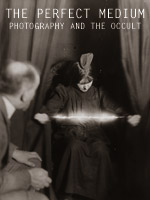

 Spirit Photo:
Eugene Thiebault: Henri Robin and Specter
Spirit Photo:
Eugene Thiebault: Henri Robin and Specter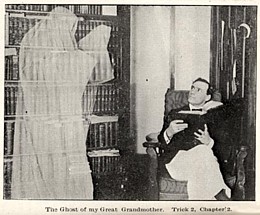

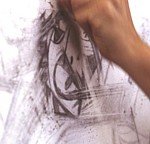
Re: Mike Bidlo: "Erased de Kooning Drawings," Francis M. Naumann Fine Art, 22 East 80th St., to Nov. 11, 2005
Once, not too long ago, I was in charge of a project that involved several artists, each making a separate installation. One of the artists -- who was, by the way, a joy to work with -- asked me to introduce him to another artist in the group. She was older, in her own way distinguished, or at least recognized in the art subgroup devoted to her particular medium. At first she smiled. But then when she recognized his name recoiled and froze as if she were being introduced to the devil.
That devil was Mike Bidlo. Humble Mike, the apostle of appropriation. Even more recently, I was told rather off-handedly by a famous feminist art historian that it was appropriation that had killed off the art world. Besides, I imagined her saying rather paradoxically, Bidlo never copies women artists. In my mind, I didn't bother explaining that his appropriationism is a comment on the art world, not a validation or rectification.
The demonization of appropriation puzzles me. The critical reception in the '80s involved a lot of then-fashionable musing about simulacra, but there was not really a gigantic market for the stuff and very little profiteering. The important appropriationists remain Mike Bidlo and Sherrie Levine. Levine, whom I admire, fits more easily into the suffering-artist category because of her lugubrious oeuvre, her celebrated copy of a Walker Evans Depression-era photograph, and because she is not as steadfastly devoted to naked appropriation. Her plywood-knot paintings and her game-board grids break the mold. Therefore, in terms of appropriation, it is Bidlo who pays the price. And who, I feel very strongly, will eventually reap the harvest.
Notwithstanding his long-standing relationship to Bruno Bischofberger, the Zurich gallerist who usually commandeers the back cover of Artforum, Bidlo seems free to show at will. He has had solos at Castelli (remember Castelli?), Gagosian, and Shafrazi. This did not prevent him from producing his East Village storefront "Saint Duchamp" installation in 1996: a doppelganger of the bottle rack and other remade Dada relics juxtaposed with novena candles in an appropriated stand, complete with kneeling pad.
On the surface, Bidlo's work is witty and benign. So why the fear? Why the tirades from the copy cops?
Deeper, much deeper than the fear of fakes is the terror of the dismantling of the real. Nothing, not even art, is what it appears to be. Are chairs and tables by the late Scott Burton art pretending to be furniture or are they furniture pretending to be art? What are we to make, as reported in The Times, of Zoe Sheehan Saldana's reracked clothing replicas, termed "shop-dropping" or "reverse shoplifiting"?
Or is the finger-pointing really projected guilt?
Here I should say that the demon-haunted diva mentioned above (who saw Bidlo as the devil incarnate) has made a career of appropriation herself. Her signature object combines a form from one culture and decoration from another, widely separated by time and geography. This is a case of the pot calling the kettle a pot. Why is it okay to borrow twice and collage two cultures, but the devil's work to borrow straight-on? Is Dada still so difficult to understand?
I guess so.
So let's try this. Artists used to learn how to make art by copying recognized examples. Later, Manet and Picasso were often "inspired" by historical artworks. But then we somehow got the idea that we should be unique from the moment we pick up a crayon. If the truth be known, everyone is influenced by everyone else -- unless you are an Outsider Artist, and we sometimes question how isolated these isolates really are. Art is really made by one artist, of all sexes and races, who has lived since our species began. Art is collective.
Nevertheless, in a world that makes originality a prime selling-point, perhaps to counter mass-production, how are you going to become original and still produce something that collectors, curators, critics and other artists will recognize as art?
There are several well-worn strategies: copy something known but that no one else has copied. You know, plunder other cultures or subcultures. Adapt Japanese prints, imitate the insane. Copy comic strips. Do not, I repeat, DO NOT start from new principles. Marcel Duchamp started from new principles and, believe it or not, there's still some debate about whether or not he produced art.
Which is the strength of his art, as it is of Bidlo's.
Art can be made by trying not to make art.
* * *

Mike Bidlo: NOT Warhol (Brillo Boxes), 1996.
What seems to anger people most about appropriation is not that it breaks the kindergarten taboo against copying, but that it questions authority -- as in author-ity, as in God the Author of the universe. Hence, since art is life, Bidlo is Satan.
But what a clever Satan.
What makes Bidlo's Picassos, Warhols, and Duchamps - carefully labeled NOT-Picasso, NOT Warhol, and NOT Duchamp -- so devilish is that they blow the lid off the copying that already takes place. Bidlo is at least honest about his copying.
He is an enthusiast. His work is Dada. Or Cubist. Or Pop. Or Abstract Expressionist. It all depends upon what art he has set out to replicate. Is Bidlo an art critic? Insofar as art historians are art critics in disguise, I'd deem him such. On the other hand, since he mostly simulates the work of dead artists, he is more an art historian than a Greenberg or a Danto.
But this may be about to change, and everyone should be nervous. "The Erased de Kooning Drawings" are the first of his appropriations using the work of a living artist. Bidlo copies a de Kooning drawing (the result recorded in the exhibition catalog and titled NOT de Kooning: Drawing... Then he erases it and it becomes NOT Robert Rauschenberg: Erased de Kooning Drawing. In 1953, Robert Rauschenberg committed one of his most infamous gestures. Using a drawing donated to him by de Kooning himself, he promptly erased it. Although de Kooning's two chief supporters, critics Thomas Hess and Harold Rosenberg, were not exactly pro-Duchamp, the artist himself was game.
But as far as I can see, Bidlo has copied not the de Kooning drawing that Rauschenberg attacked with an eraser, but 16 others, all documented in the catalog produced for the Naumann Gallery exhibition. Bidlo is appropriating Rauschenberg's gesture, not the original drawing and its erased results. That he includes two glass urns of the accumulated erasure residue and a DVD documenting the process more than hints that these new works are in the same category as his Klein, Warhol, and Pollock performances.
Bidlo is investigating modernism. The artist told me he was much taken with something a Japanese artist had told him. As a child, he had been given a watch, and in order to understand how it worked had immediately taken it apart. And that was what he, Mike Bidlo, was doing with art.
But did Bidlo's admirer put that watch back together?
* * *

Andy Warhol: NOT Mike Bidlo
An addendum to "The Erased de Kooning Drawings" is provided by the exorcism of another art parable. In 1949, the painter Clifford Still was invited to participate in an exhibition of large drawings to be held at the Palace of the Legion of Honor in San Francisco. He was so insulted -- Still was always being insulted - that he submitted a blank canvas. It is a testament to Bidlo's depth as an art critic that these blank canvases are the only Stills he has appropriated. Were they art? They might have been inspired by paranoia or hubris, but at least they were not infected by the bombast of Still's "serious" paintings. Six identical versions of Still's legendary "drawing" are presented here, looking curiously and decoratively architectural. Because of the context, we will, of course, also remember Rauschenberg's more famous, larger, all-white canvases, once justifiably praised to the hilt by John Cage, which were definitely not inspired by paranoia or hubris.
Although Bidlo's art is as conceptual as any minimalist - or conceptualist - he is thought of by some as a wild card. We know, however, that Bidlo's replicas will some day be as valuable as their subjects. Given enough time, they may be more valuable, since reputations bounce up and down. Art history is fickle. Will Bidlo replicas have any meaning if their subjects disappear? Why is it still pointless to replicate Bidlo's replicas?
In the meantime, what could be more subversive than the implication that if you are in love with a work of art you can't buy, copy it. If artworks do not have mana or as Walter Benjamin would say, aura, then what's the harm? Will anyone in the super-materialist art world really admit to believing in mana or aura?
AJ Ads
AJ Arts Blog Ads
Now you can reach the most discerning arts blog readers on the internet. Target individual blogs or topics in the ArtsJournal ad network.
Advertise Here
AJ Blogs
AJBlogCentral | rssculture
Terry Teachout on the arts in New York City
Andrew Taylor on the business of arts & culture
rock culture approximately
Rebuilding Gulf Culture after Katrina
Richard Kessler on arts education
Douglas McLennan's blog
Art from the American Outback
For immediate release: the arts are marketable
No genre is the new genre
John Rockwell on the arts
Jan Herman - arts, media & culture with 'tude
dance
Apollinaire Scherr talks about dance
Tobi Tobias on dance et al...
jazz
Howard Mandel's freelance Urban Improvisation
Focus on New Orleans. Jazz and Other Sounds
Doug Ramsey on Jazz and other matters...
media
Jeff Weinstein's Cultural Mixology
Martha Bayles on Film...
classical music
Greg Sandow performs a book-in-progress
Exploring Orchestras w/ Henry Fogel
Harvey Sachs on music, and various digressions
Kyle Gann on music after the fact
Greg Sandow on the future of Classical Music
Norman Lebrecht on Shifting Sound Worlds
publishing
Jerome Weeks on Books
Scott McLemee on books, ideas & trash-culture ephemera
theatre
Wendy Rosenfield: covering drama, onstage and off
Chloe Veltman on how culture will save the world
Elizabeth Zimmer on time-based art forms
visual
Public Art, Public Space
John Perreault's art diary
Lee Rosenbaum's Cultural Commentary
Tyler Green's modern & contemporary art blog
